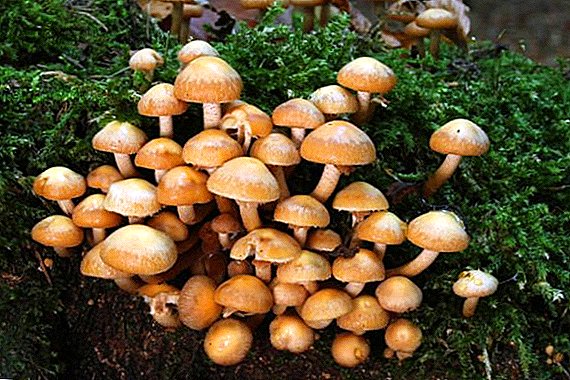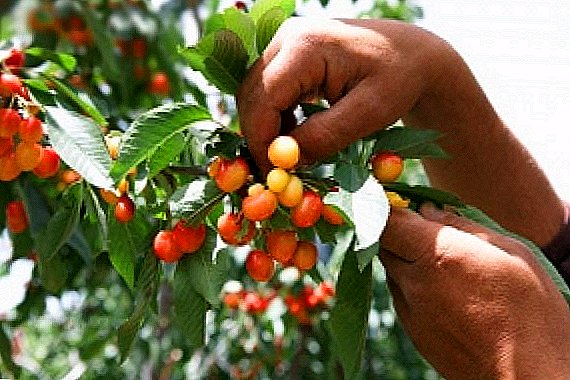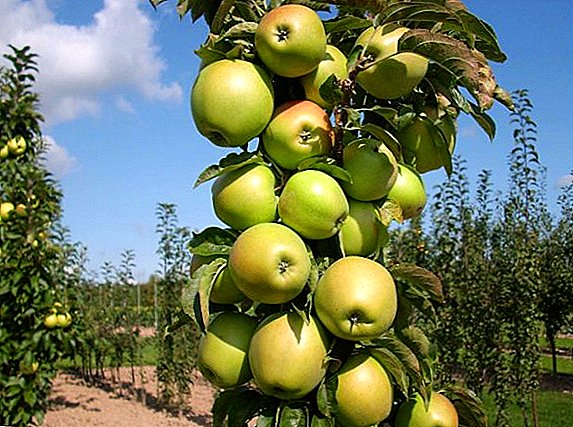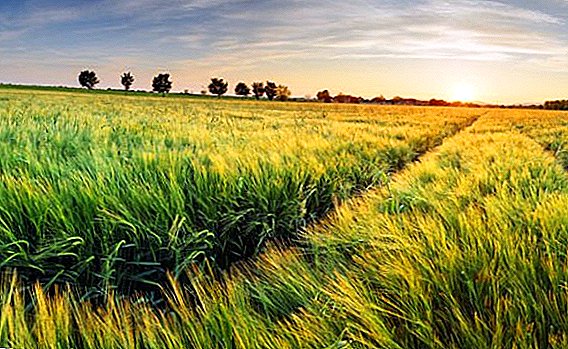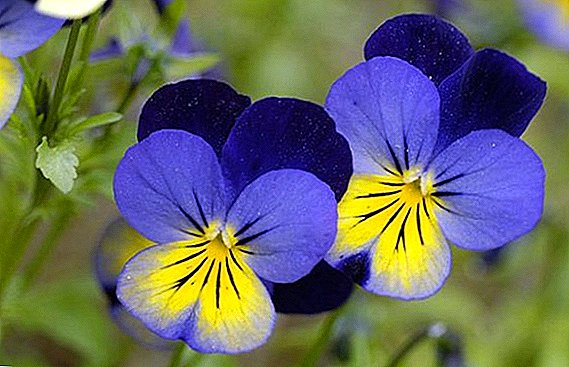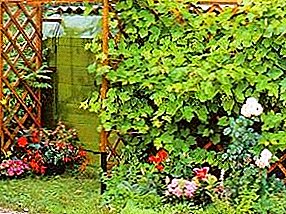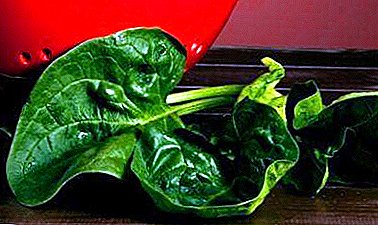
Spinach has long been a favorite part of our menu, both everyday and festive. There is simply a huge variety of varieties of this plant, among them spinach oil. It is incredibly healthy, tasty, and very beautiful.
The article provides detailed information about the properties and technology of growing this incredibly delicate-to-taste early-ripening variety. We'll tell all about the pros and cons of this variety and help grow healthy greens.
Botanical description and history
Spinach Fat leaf is a herbaceous vegetable from the Amaranth family.
The height reaches forty centimeters, the leaves may have a different shape - oval, notched or peristopal, their surface may be even or slightly bumpy.
 The color of the leaves is dark green. Compact socket - no more than 28 centimeters. On a male plant, flower stalks quickly form, on a female plant the seeds ripen.
The color of the leaves is dark green. Compact socket - no more than 28 centimeters. On a male plant, flower stalks quickly form, on a female plant the seeds ripen.
The plant is early ripe. From the moment of emergence of shoots to full maturity only a month passes. Resistant to frost. We have known this vegetable for no more than two hundred years, but spinach from ancient Persia. In Europe, he came to the Middle Ages.
The first to appreciate it were the Spanish monks, who began to cultivate the culture in the monastery gardens. In the 16-17 centuries, this variety belonged to the delicacy.
Medicinal properties and chemical composition
Based on 100 grams of the product, spinach contains:
- Vitamins:
- beta carotene - 4.5 mg;
- A - 750 mcg;
- B1 - 0.1 mg;
- B2 - 0.25 mg;
- B5 - 0.3 mg;
- B6 - 0.1 mg;
- B9 - 80 µg;
- C - 55 mg;
- E - 2.5 mg;
- H - 0.1 μg;
- K- 482.9 mcg;
- PP - 1.2 mg;
- Choline - 18 mg.
- Macro and trace elements:
- Ca - 106 mg;
- Mg - 82 mg;
- Na - 24 mg;
- K - 774 mg;
- P - 83 mg;
- Fe — 13.51 mg;
- Zn - 0.53 mg;
- Cu - 13 µg;
- Mn - 0.897 mg;
- Se - 1 mcg.
Contraindications
- Urolithiasis and renal stone disease.
- Cholelithiasis.
- Gout.
- Rheumatism.
- Diseases of the duodenum.
Where is it used?
In cooking
 It is an excellent dye.
It is an excellent dye.- Add to canned or canned it separately.
- Butter spinach is used as a filling for pies.
- The leaves are added to vegetable salads, sauces and snacks.
- Spinach meat patties are easier to digest.
Compared with other varieties can not interrupt the taste of dishes, which include, but only slightly shade it.
In medicine
- Applied in the treatment of gastritis.
- Eating spinach leaves is effective for anemia and hypertension.
- The complex therapy is indispensable in the treatment of enterocolitis.
- Spinach is useful for the thyroid gland.
- It has the ability to relieve fatigue and tension from the eyes.
- The constant use of spinach has a beneficial effect on the teeth and gums.
How is the taste different?
Compared to other varieties fat spinach taste is more neutral, very lightcreamy and tender.
Cultivation and care
Spinach requires fertile and rich in organic acidic soil with good drainage. Landing on sandy loams or loams is especially good. Spinach is fed rarely: the vegetable grows quickly and it is able to accumulate nitrates. Potash and phosphate fertilizers can be applied only in the fall, in the excavated soil.
For culture requires abundant watering, regular weeding and loosening, when the plant reaches ten centimeters in height, planting should be thinned out. Watering is carried out in the morning and in the evening in dry weather, if it has rained, then not earlier than in two days.
Temperature conditions depend on the region of cultivation, so, in regions with summer indicators not higher than +20, fat-leaved spinach is planted in August-September in order to get a full harvest at the end of spring. For other regions fat spinach culture unpretentious and feels quite comfortable with summer indicators of + 25 + 27 degrees.
How to plant in the garden in open ground?
Seeds
 Seed preparation is that they are placed in warm water for two days, then taken out and dried well.
Seed preparation is that they are placed in warm water for two days, then taken out and dried well.- Sow spinach in two stages - in the fall, with the first shoots appear as soon as the snow melts and in the spring.
- When spring planting, if the soil is very compacted and oily, use the garden method, for all other soil types, planting is practiced in rows.
- In the ground, at a distance of 25-30 cm, make grooves-rows, a depth of no more than two or three centimeters.
- Sow and close up loose soil.
- As soon as the first sprouts break through, they monitor that the access of oxygen to the roots is sufficient, for this the soil is loosened.
Seedlings
- In the seedling variant of cultivation, seeds are sown in peat pots.
- Landing is carried out in April-May.
- Seedlings are placed at a distance of five to ten centimeters from each other, put the pot in the hole and sprinkle with earth.
More laborious, but also having the right to life option for transplanting - growing seedlings in boxes or plastic containers. Such planting material is transplanted into the ground by the method of transshipment.
Features of growing at home
Bulbroot spinach is also suitable for home cultivation. - on the glazed balconies, on the windowsills on the south side. If the windows face north, you need to use additional lighting. Sowing is done in flower pots every month, due to the fact that spinach is usable no more than eight weeks. Thus, you can establish a smooth receipt of greens. Plants that survived several cuts and gave arrows are removed from the root.
The landing process is as follows:
- At the bottom of a two-liter pot is laid drainage.
- Soil mixture can be taken for indoor plants.
- Seeds are deepened no more than one centimeter, watered and covered with film.
- After the emergence of seedlings, it is about a week, the film is removed.
- Sufficient temperature + 15 + 18 degrees.
- Care is regular watering and fertilizing once every ten days (you can use fertilizer for indoor plants).
So that spinach does not skirmish as long as possible, it is regularly sprayed or twice a week, washed with a jet from the shower.
When to harvest?
The appearance on the plant of six to eight leaves, a signal that spinach can be collected. The maximum period of harvest - the appearance of flower stalks. You can collect in various ways: mow, cut or pull up with the root.
Where to buy seeds?
 Seeds and seedlings can be purchased in specialized stores. If the seed planting method is chosen, it is necessary to pay attention to the seed material is fresh.
Seeds and seedlings can be purchased in specialized stores. If the seed planting method is chosen, it is necessary to pay attention to the seed material is fresh.
Seedlings acquire in the phase of two or three leaves. It should not be damaged and yellowed parts.
The price of seeds for Moscow and St. Petersburg ranges from 25 to 50 rubles, depending on the manufacturer. Seedlings in Moscow can be purchased at a price of 40 rubles for the spine, in St. Petersburg - 30-35 rubles.
Diseases and pests
Butter spinach is subject to all kinds of rot: root or top of a plant:
- Fusarium;
- perinospora;
- anthracnose;
- curly, cucumber mosaic.
The larvae of the mining fly bring significant damage to crops. To avoid infection, you need to plant spinach away from the beets and in time to remove the affected plants.
It is not at all difficult to get the harvest of leafy spinach both in the open field and at home, given the precocity of the crop and the simple cultivation technique. Even a beginning gardener can cope with this task. Anyone can grow spinach in this class..


 It is an excellent dye.
It is an excellent dye. Seed preparation is that they are placed in warm water for two days, then taken out and dried well.
Seed preparation is that they are placed in warm water for two days, then taken out and dried well.